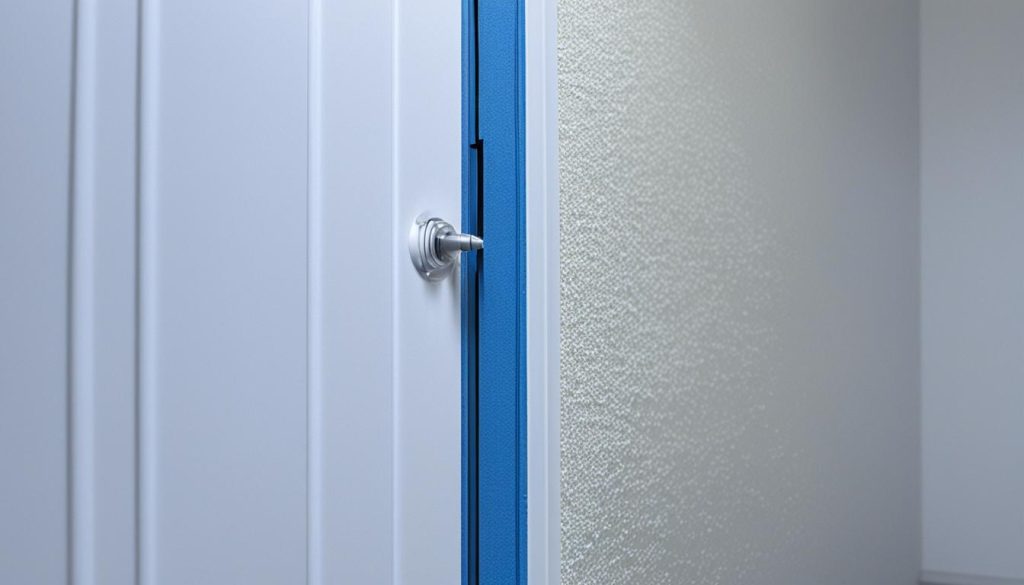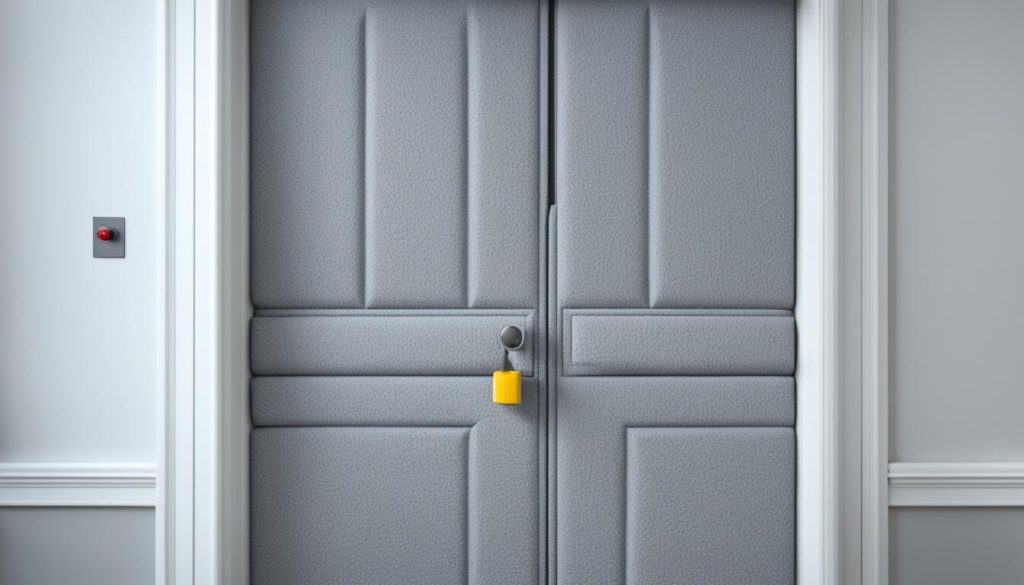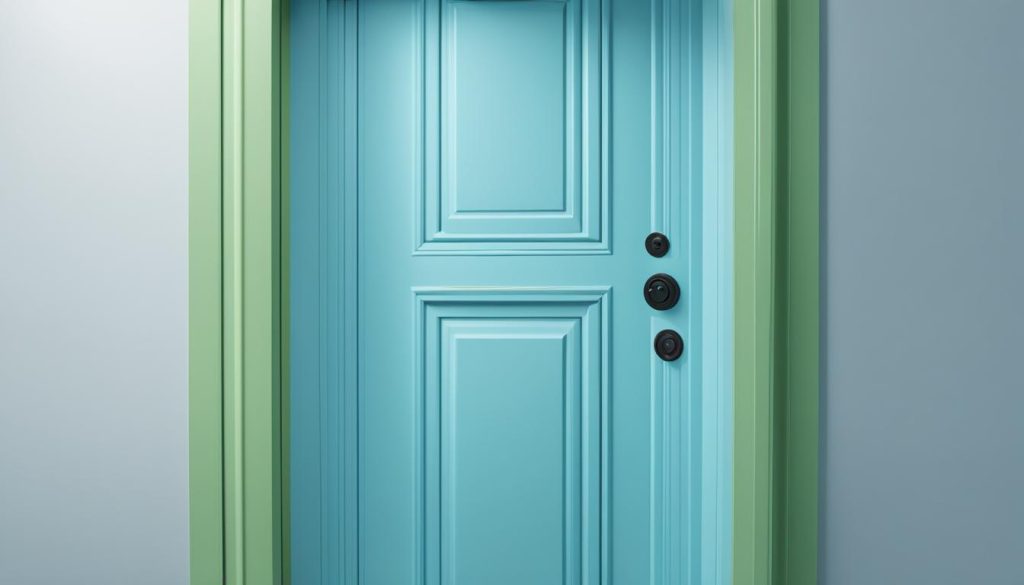Are you tired of the relentless assault of noise invading your personal space? Imagine a sanctuary where tranquility reigns supreme, shielding you from the cacophony of the outside world. Discover how to soundproof a door and unlock the secrets to a peaceful abode. we unveil the mysteries of soundproofing, empowering you to transform your door into an impenetrable barrier against unwelcome noise. Delve into a world where bustling streets, chatty neighbors, and household commotion fade into oblivion.
Embark on a journey through a myriad of soundproofing techniques, from ingenious household hacks to the intricate science behind acoustic doors. Tailor these solutions to your needs, budget, and desired oasis of calm.
Importance of Door Soundproofing

When it comes to creating a peaceful and comfortable living space, soundproofing your doors is essential. The impact of noise pollution on health and well-being cannot be underestimated. Excessive noise can disrupt sleep, increase stress levels, and negatively affect concentration and productivity. It can also lead to long-term health issues such as cardiovascular problems and mental health disorders.
Assessing the vulnerability of doors to sound leakage is crucial in understanding the need for effective soundproofing measures. Doors are common areas where sound can easily penetrate, especially if they are not properly sealed. Sound leakage through doors can result in significant noise transmission between different areas of your home, compromising your privacy and overall comfort.
By implementing soundproofing solutions for your doors, you can significantly reduce the impact of noise pollution and create a peaceful environment for yourself and your family. Let’s explore some effective methods and techniques to soundproof your doors in the following sections.
Identifying the Weak Points in Door Structure
When it comes to soundproofing a door, it’s crucial to identify the weak points in its structure that allow sound to leak through. By addressing these areas of vulnerability, you can significantly enhance the soundproofing effectiveness of your door.
Let’s take a closer look at the different components of a door and the common areas where sound can penetrate:
1. Door Frame: The door frame plays a critical role in determining the overall acoustic performance of the door. Gaps and inconsistencies in the frame can allow sound to leak in and out. Pay close attention to the corners and edges of the frame to ensure a tight seal.
2. Door Joints: The joints where the door meets the frame are particularly prone to sound leakage. These areas should be carefully examined for any gaps or spaces that need to be sealed.
3. Door Panel: The door panel itself can contribute to sound leakage if it lacks sufficient density or insulation. Hollow-core doors, for example, are more susceptible to sound transmission than solid-core doors.
4. Door Hardware: Components such as hinges, handles, and locks can create points of weakness in the door structure. Look for gaps or loose fittings that may be compromising the door’s ability to block sound.
5. Windows or Glass Inserts: If your door features windows or glass inserts, these areas can be significant sources of sound leakage. Consider using double or laminated glass and ensure that the frames around the glass are well-sealed.
6. Letterbox or Mail Slot: If your door has a letterbox or mail slot, it can provide a direct pathway for sound to enter your space. Installing a soundproof letterbox or sealing the mail slot can help minimize noise penetration.
By addressing these weak points in the door’s structure, you can significantly reduce sound leakage and create a more peaceful and quiet environment. Let’s move on to the next section to explore some cost-effective solutions to soundproof your door using household products.
How to Soundproof a Door with Household Products
Using Weatherstripping to Seal Gaps
If you want to soundproof your door without breaking the bank, weatherstripping is an effective and affordable solution. Weatherstripping involves using adhesive strips or tapes to seal gaps around the edges of the door, preventing sound from leaking in or out. This method not only helps reduce noise transmission but also improves energy efficiency and insulation.
To weatherstrip your door, follow these steps:
- Start by thoroughly cleaning the door frame and ensuring it is dry.
- Measure the lengths of weatherstripping needed for each side of the door frame and cut them to size.
- Peel off the backing from the adhesive side of the weatherstripping and carefully apply it along the edges of the door frame. Press firmly to ensure a secure attachment.
- Repeat the process for all sides of the door frame, including the top and bottom.
- Close the door to check for any gaps that may still be present. If necessary, add additional weatherstripping to fill in the remaining spaces.
Weatherstripping materials such as foam, vinyl, or rubber are readily available at hardware stores and online. Choose a material that is durable, weather-resistant, and specifically designed for soundproofing purposes to achieve the best results.
Applying Acoustic Caulk for a Tighter Seal

To further enhance the soundproofing capabilities of your door, consider using acoustic caulk. Acoustic caulk is a specialized sealant designed to fill in gaps, cracks, and joints, creating a tight and soundproof seal.
Here’s how you can apply acoustic caulk to your door:
- Clean the surfaces where you plan to apply the caulk, ensuring they are free from dirt, dust, and debris.
- Load the acoustic caulk tube into a caulk gun, then cut the tip of the tube at an angle.
- Apply a continuous bead of caulk along the gaps and cracks, focusing on areas where sound is likely to leak through.
- Smooth out the caulk using a caulk finishing tool or your finger, ensuring it creates a seamless and even seal.
- Allow the caulk to dry and cure according to the manufacturer’s instructions.
Acoustic caulk is available in most hardware stores and online retailers. Look for a caulk that is specifically labeled as “acoustic” or “soundproofing” to ensure its effectiveness.
Optimizing Door Soundproofing with Mass Increase
When it comes to soundproofing doors, increasing mass is a crucial factor in achieving effective noise reduction. By adding weight to the door, you can create a barrier that absorbs and blocks sound waves, resulting in a quieter and more peaceful environment. In this section, we will explore the concept of mass increase and its role in optimizing door soundproofing.
Choosing the Right Materials for Adding Mass
Choosing the right materials to add mass to your door is essential for maximizing soundproofing capabilities. Opt for dense and heavyweight materials that can effectively absorb and dampen sound waves. Some commonly used materials for adding mass to doors include:
- Mass-loaded vinyl (MLV): MLV is a dense, flexible material that can be attached to the door surface to increase its mass and reduce sound transmission.
- Green Glue Compound: Green Glue is a viscoelastic compound that, when applied between two rigid layers of material, significantly enhances soundproofing performance.
- Fiberglass insulation: Fiberglass insulation can be used to fill the hollow cavities of the door, increasing its density and improving sound absorption.
When selecting materials, consider their mass per unit area and the overall weight they will add to the door. Aim for a substantial mass increase while ensuring that the door can still function properly without any strain or damage.
The Role of Density in Blocking Noise
Density plays a crucial role in effectively blocking noise transmission through doors. As a general rule, higher-density materials are more effective at absorbing and reflecting sound waves. By increasing the density of the door, you can significantly reduce sound leakage and improve soundproofing performance.
When selecting materials, consider their density in relation to their soundproofing capabilities. Look for materials with higher density ratings as they will provide better noise reduction. Additionally, ensure proper installation and coverage to maximize the density’s impact on soundproofing.

| Materials for Adding Mass to Doors | Density |
|---|---|
| Mass-loaded vinyl (MLV) | 1.5 lbs/ft2 |
| Green Glue Compound | 2.0 lbs/gallon |
| Fiberglass insulation | 1.5-2.5 lbs/ft3 |
The table above showcases different materials for adding mass to doors along with their respective density ratings. While these materials are commonly used, it’s important to assess your specific requirements and consult with a soundproofing professional to determine the most suitable materials for your door.
By understanding the principles behind mass increase and the role of density in blocking noise, you can optimize the soundproofing capabilities of your doors and create a more peaceful and comfortable living or working space.
The Mechanics Behind Acoustic Doors
Acoustic doors are specially designed to provide effective soundproofing solutions, ensuring a peaceful and quiet environment. Understanding the mechanics behind these doors can help you make informed decisions when it comes to soundproofing your space.
Differentiating Between Standard and Acoustic Doors
Standard doors prioritize aesthetics and basic functionality over soundproofing, offering minimal noise reduction. In contrast, acoustic doors are engineered with advanced features to block noise transmission and minimize sound leakage. They are constructed with specialized materials and components to enhance their soundproofing performance. Acoustic doors are designed to absorb and dampen sound waves, preventing noise transmission through the door. Additionally, they are equipped with seals and gaskets to create an airtight and soundproof barrier
Understanding Rw Ratings and Their Relevance
The sound reduction index (Rw) is an important metric used to measure the soundproofing performance of doors. The Rw rating indicates the amount of sound reduction achieved by the door, expressed in decibels (dB). The higher the Rw rating, the better the door’s soundproofing capabilities.
The Rw rating takes into account both airborne and impact sounds, providing a comprehensive assessment of the door’s ability to block noise. It considers factors such as the door’s construction, materials used, and sealing mechanisms. It’s important to note that the Rw rating should be evaluated within the context of your specific soundproofing requirements.
When selecting acoustic doors, look for products with higher Rw ratings to ensure effective soundproofing. However, it’s essential to consider other factors, such as door size, installation, and the overall soundproofing strategy for your space.
Cost-effective Solutions to Door Soundproofing Issues
When it comes to soundproofing your doors, you don’t always have to break the bank. There are cost-effective solutions that can effectively reduce noise transmission and create a quieter environment in your home or office. In this section, we will explore some affordable DIY options for door soundproofing, as well as the use of door sweeps and gaskets as practical and effective solutions.
Exploring Affordable DIY Options
DIY soundproofing options are budget-friendly and effective for improving door soundproofing. Weatherstripping is an accessible choice, sealing gaps around the door to prevent sound leakage. Acoustic caulk is another affordable option, filling door frame gaps to reduce noise transmission. These materials are easy to find at hardware stores and simple to apply without professional help. With these DIY methods, you can enhance your door’s soundproofing without breaking the bank.
Utilizing Door Sweeps and Gaskets
Door sweeps and gaskets are simple yet effective tools for enhancing door soundproofing. They are designed to seal the gap between the bottom of the door and the floor, preventing sound from passing through this vulnerable area.
A door sweep is a strip of material, often made of rubber or vinyl, that is attached to the bottom of the door. It creates a seal when the door is closed, blocking noise and reducing drafts. Door sweeps are easy to install and can significantly improve the soundproofing capabilities of your door.
A gasket, on the other hand, is a flexible seal that can be applied around the door frame. It fills the gap between the door and the frame, providing an additional barrier against sound transmission. Gaskets are available in various materials and can be purchased in adhesive-backed strips for easy installation.

By utilizing door sweeps and gaskets, you can enhance the soundproofing of your doors without extensive renovations or costly solutions. These affordable options can make a significant difference in reducing noise levels and creating a more peaceful and quiet environment.
In the next section, we will explore tips and tricks for tackling external door noise, providing you with strategies to minimize noise penetration through external doors.
Tackling External Door Noise: Tips and Tricks
Minimizing noise through external doors is essential for creating a peaceful and quiet indoor environment. Whether you live in a noisy neighborhood or close to a bustling street, reducing external door noise can greatly enhance your overall comfort and well-being. In this section, we will provide you with practical tips and tricks to soundproof your external doors effectively.
To start, let’s address one of the most common sources of noise leakage: weak seals. Over time, door seals can deteriorate, creating gaps that allow noise to easily infiltrate your space. Inspect your doors for any signs of wear and tear, paying close attention to the areas around the door frame and threshold. If you notice any gaps, consider installing weatherstripping to seal them off. Weatherstripping comes in various forms, such as adhesive strips or sweeps, and can significantly reduce noise penetration.
Professional versus DIY: Evaluating Soundproofing Approaches
When it comes to soundproofing your doors, you have two main options to consider: hiring professional soundproofing services or taking the DIY route. Each approach has its pros and cons, and evaluating them can help you make an informed decision based on your individual needs, budget, and desired outcomes.
Professional soundproofing services offer expertise and convenience. Professional soundproofing companies have the knowledge and experience to assess your specific soundproofing needs and recommend the most effective solutions. They can handle all aspects of the project, from assessing the weak points in your doors to installing the necessary materials. This approach saves you time and ensures that the job is done correctly.
On the other hand, DIY soundproofing allows you to take matters into your own hands. It can be a more budget-friendly option, as you can choose to use affordable materials and perform the work yourself. DIY soundproofing also gives you the flexibility to experiment with different solutions and customize them to your preferences. However, keep in mind that the success of your DIY project will largely depend on your skills, knowledge, and attention to detail.
Ultimately, the decision between professional soundproofing and DIY comes down to your priorities. If you value convenience and want the best possible results, professional services may be worth the investment. However, if you have a limited budget and enjoy tackling home improvement projects, DIY soundproofing can be a rewarding experience. Whichever approach you choose, remember to assess your needs and consider the long-term benefits of soundproofing your doors.
FAQs on Soundproofing Door
What materials can block sound?
There are various materials that can block sound effectively, including mass-loaded vinyl (MLV), acoustic foams, soundproof curtains, and door sweeps and gaskets. These materials are designed to absorb or reflect sound waves, minimizing sound transmission through doors and other surfaces.
Can a wooden door be soundproof?
While wooden doors are not inherently soundproof, they can be made more soundproof by employing various techniques. Adding mass to the door, sealing gaps and cracks, and using sound-absorbing materials such as MLV or acoustic panels can significantly improve the soundproofing capabilities of a wooden door.
Does putting a towel under the door work for noise?
Placing a towel under the door can provide a temporary solution to reducing noise leakage through the bottom gap. However, it is not a foolproof method as towels do not offer significant soundproofing properties. For better results, consider using a door draft stopper or door sweep, which are specifically designed to block noise and create a tighter seal.

